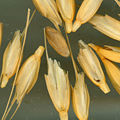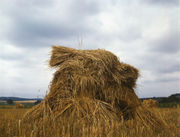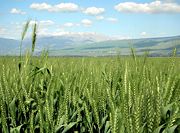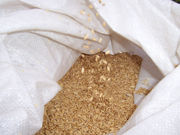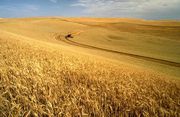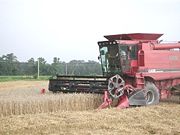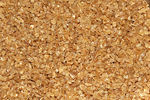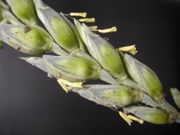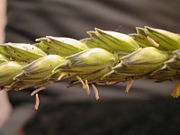Wheat
2008/9 Schools Wikipedia Selection. Related subjects: Food
| Scientific classification | ||||||||||||||||
|---|---|---|---|---|---|---|---|---|---|---|---|---|---|---|---|---|
|
||||||||||||||||
| Species | ||||||||||||||||
|
T. aestivum |
Wheat (Triticum spp.) is a worldwide cultivated grass from the Levant area of the Middle East. Globally, after maize, wheat is the second most produced food among the cereal crops; rice ranks third. Wheat grain is a staple food used to make flour for leavened, flat and steamed breads; cookies, cakes, pasta, noodles and couscous; and for fermentation to make beer, alcohol, vodka or biofuel. Wheat is planted to a limited extent as a forage crop for livestock, and the straw can be used as fodder for livestock or as a construction material for roofing thatch.
Although wheat supplies much of the world's dietary protein and food supply, as many as one in every 100 to 200 persons in the United States has Coeliac disease, a condition which results from an inappropriate immune system response to a protein found in wheat: gluten.
History
Wheat originated in Southwest Asia in the area known as the Fertile crescent. The genetic relationships between einkorn and emmer indicate that the most likely site of domestication is near Diyarbakır in Turkey. These wild wheats were domesticated as part of the origins of agriculture in the Fertile Crescent. Cultivation and repeated harvesting and sowing of the grains of wild grasses led to the domestication of wheat through selection of mutant forms with tough ears which remained intact during harvesting, larger grains, and a tendency for the spikelets to stay on the stalk until harvested. Because of the loss of seed dispersal mechanisms, domesticated wheats have limited capacity to propagate in the wild.
The cultivation of wheat began to spread beyond the Fertile Crescent during the Neolithic period. The oldest wheat found thus far is from Çatalhöyük, a Neolithic settlement in southern Anatolia. The wheat samples discovered were found to be 8,500 years old. By 5,000 years ago, wheat had reached Ethiopia, India, Great Britain, Ireland and Spain. A millennium later it reached China. Three thousand years ago agricultural cultivation with horse drawn plows increased cereal grain production, as did the use of seed drills to replace broadcast sowing in the 18th century. Yields of wheat continued to increase, as new land came under cultivation and with improved agricultural husbandry involving the use of fertilizers, threshing machines and reaping machines, tractor-drawn cultivators and planters, and better varieties (see green revolution and Norin 10 wheat). With population growth rates falling in the more technologically advanced countries, while yields continue to rise, the area devoted to wheat may now begin to decline for the first time in modern human history. But now in 2007 wheat stocks have reached their lowest since 1981, and 2006 was the first year in which the world consumed more wheat than the world produced - a gap that is continuously widening as the requirement for wheat increases beyond production.
Genetics
Wheat genetics is more complicated than that of most other domesticated species. Some wheat species are diploid, with two sets of chromosomes, but many are stable polyploids, with four sets of chromosomes ( tetraploid) or six ( hexaploid).
- Einkorn wheat (T. monococcum) is diploid.
- Most tetraploid wheats (e.g. emmer and durum wheat) are derived from wild emmer, T. dicoccoides. Wild emmer is the result of a hybridization between two diploid wild grasses, T. urartu and a wild goatgrass such as Aegilops searsii or Ae. speltoides. The hybridization that formed wild emmer occurred in the wild, long before domestication.
- Hexaploid wheats evolved in farmers' fields. Either domesticated emmer or durum wheat hybridized with yet another wild diploid grass ( Aegilops tauschii) to make the hexaploid wheats, spelt wheat and bread wheat.
Plant breeding
In traditional agricultural systems wheat populations often consist of landraces, informal farmer-maintained populations that often maintain high levels of morphological diversity. Although landraces of wheat are no longer grown in Europe and North America, they continue to be important elsewhere. The origins of formal wheat breeding lie in the nineteenth century, when single line varieties were created through selection of seed from a single plant noted to have desired properties. Modern wheat breeding developed in the first years of the twentieth century and was closely linked to the development of Mendelian genetics. The standard method of breeding inbred wheat cultivars is by crossing two lines using hand emasculation, then selfing or inbreeding the progeny. Selections are identified (shown to have the genes responsible for the varietal differences) ten or more generations before release as a variety or cultivar.
F1 hybrid wheat cultivars should not be confused with wheat cultivars deriving from standard plant breeding. Heterosis or hybrid vigor (as in the familiar F1 hybrids of maize) occurs in common (hexaploid) wheat, but it is difficult to produce seed of hybrid cultivars on a commercial scale as is done with maize because wheat flowers are complete and normally self-pollinate. Commercial hybrid wheat seed has been produced using chemical hybridizing agents, plant growth regulators that selectively interfere with pollen development, or naturally occurring cytoplasmic male sterility systems. Hybrid wheat has been a limited commercial success in Europe (particularly France), the USA and South Africa.
The major breeding objectives include high grain yield, good quality, disease and insect resistance and tolerance to abiotic stresses include mineral, moisture and heat tolerance. The major diseases in temperate environments include Fusarium head blight, leaf rust and stem rust, whereas in tropical areas spot blotch (wheat) (also known as Helminthosporium leaf blight). See physiological and molecular wheat breeding
Hulled versus free-threshing wheat
The four wild species of wheat, along with the domesticated varieties einkorn, emmer and spelt, have hulls (in German, Spelzweizen). This more primitive morphology consists of toughened glumes that tightly enclose the grains, and (in domesticated wheats) a semi-brittle rachis that breaks easily on threshing. The result is that when threshed, the wheat ear breaks up into spikelets. To obtain the grain, further processing, such as milling or pounding, is needed to remove the hulls or husks. In contrast, in free-threshing (or naked) forms such as durum wheat and common wheat, the glumes are fragile and the rachis tough. On threshing, the chaff breaks up, releasing the grains. Hulled wheats are often stored as spikelets because the toughened glumes give good protection against pests of stored grain.
Naming
There are many botanical classification systems used for wheat species, discussed in a separate article on Wheat taxonomy. The name of a wheat species from one information source may not be the name of a wheat species in another. Within a species, wheat cultivars are further classified by wheat breeders and farmers in terms of growing season, such as winter wheat vs. spring wheat, by gluten content, such as hard wheat (high protein content) vs. soft wheat (high starch content), or by grain colour (red, white or amber).
In British English wheat may be referred to as corn.
Major cultivated species of wheat
- Common wheat or Bread wheat — (T. aestivum) A hexaploid species that is the most widely cultivated in the world.
- Durum — (T. durum) The only tetraploid form of wheat widely used today, and the second most widely cultivated wheat.
- Einkorn — (T. monococcum) A diploid species with wild and cultivated variants. Domesticated at the same time as emmer wheat, but never reached the same importance.
- Emmer — (T. dicoccon) A tetraploid species, cultivated in ancient times but no longer in widespread use.
- Spelt — (T. spelta) Another hexaploid species cultivated in limited quantities.
In the United States
Classes used in the United States are
- Durum — Very hard, translucent, light colored grain used to make semolina flour for pasta.
- Hard Red Spring — Hard, brownish, high protein wheat used for bread and hard baked goods. Bread Flour and high gluten flours are commonly made from hard red spring wheat. It is primarily traded at the Minneapolis Grain Exchange.
- Hard Red Winter — Hard, brownish, mellow high protein wheat used for bread, hard baked goods and as an adjunct in other flours to increase protein in pastry flour for pie crusts. Some brands of unbleached all-purpose flours are commonly made from hard red winter wheat alone. It is primarily traded by the Kansas City Board of Trade. One variety is known as "turkey red wheat", and was brought to Kansas by Mennonite immigrants from Russia.
- Soft Red Winter — Soft, low protein wheat used for cakes, pie crusts, biscuits, and muffins. Cake flour, pastry flour, and some self-rising flours with baking powder and salt added for example, are made from soft red winter wheat. It is primarily traded by the Chicago Board of Trade.
- Hard White — Hard, light colored, opaque, chalky, medium protein wheat planted in dry, temperate areas. Used for bread and brewing.
- Soft White — Soft, light colored, very low protein wheat grown in temperate moist areas. Used for pie crusts and pastry. Pastry flour, for example, is sometimes made from soft white winter wheat.
Hard wheats are harder to process and red wheats may need bleaching. Therefore, soft and white wheats usually command higher prices than hard and red wheats on the commodities market.
As a food
| Wheat germ, crude Nutritional value per 100 g (3.5 oz) |
|||||||||||||||||||||||||||||||||
|---|---|---|---|---|---|---|---|---|---|---|---|---|---|---|---|---|---|---|---|---|---|---|---|---|---|---|---|---|---|---|---|---|---|
| Energy 360 kcal 1510 kJ | |||||||||||||||||||||||||||||||||
|
|||||||||||||||||||||||||||||||||
| Percentages are relative to US recommendations for adults. Source: USDA Nutrient database |
|||||||||||||||||||||||||||||||||
Raw wheat can be powdered into flour, germinated and dried creating malt, crushed and de-branned into cracked wheat, parboiled (or steamed), dried, crushed and de-branned into bulgur, or processed into semolina, pasta, or roux. They are a major ingredient in such foods as bread, breakfast cereals (e.g. Wheatena, Cream of Wheat, Shredded Wheat), porridge, crackers, biscuits, pancakes, cakes, gravy and boza (a fermented beverage).
Nutrition
100 grams of hard red winter wheat contain about 12.6 grams of protein, 1.5 grams of total fat, 71 grams of carbohydrate (by difference), 12.2 grams of dietary fibre, and 3.2 mg of iron (17% of the daily requirement); the same weight of hard red spring wheat contains about 15.4 grams of protein, 1.9 grams of total fat, 68 grams of carbohydrate (by difference), 12.2 grams of dietary fibre, and 3.6 mg of iron (20% of the daily requirement).
Gluten, a protein found in wheat (and other Triticeae), cannot be tolerated by people with celiac disease (an autoimmune disorder in ~1% of Indo-European populations).
Health concerns
Roughly 1% of the population has coeliac or celiac disease—a condition that is caused by an adverse immune system reaction to gliadin, a gluten protein found in wheat (and similar proteins of the tribe Triticeae which includes other cultivars such as barley and rye). Upon exposure to gliadin, the enzyme tissue transglutaminase modifies the protein, and the immune system cross-reacts with the bowel tissue, causing an inflammatory reaction. That leads to flattening of the lining of the small intestine, which interferes with the absorption of nutrients. The only effective treatment is a lifelong gluten-free diet. While the disease is caused by a reaction to wheat proteins, it is not the same as wheat allergy.
Economics
| Top Ten Wheat Producers — 2005 (million metric ton) | |
|---|---|
| 96 | |
| 72 | |
| 57 | |
| 46 | |
| 37 | |
| 26 | |
| 24 | |
| 24 | |
| 22 | |
| 21 | |
| World Total | 626 |
| Source: UN Food & Agriculture Organisation (FAO) | |
Harvested wheat grain that enters trade is classified according to grain properties (see below) for the purposes of the commodities market. Wheat buyers use the classifications to help determine which wheat to purchase as each class has special uses. Wheat producers determine which classes of wheat are the most profitable to cultivate with this system.
Wheat is widely cultivated as a cash crop because it produces a good yield per unit area, grows well in a temperate climate even with a moderately short growing season, and yields a versatile, high-quality flour that is widely used in baking. Most breads are made with wheat flour, including many breads named for the other grains they contain like most rye and oat breads. The popularity of foods made from wheat flour creates a large demand for the grain, even in economies with significant food surpluses.
In 2007 there was a dramatic rise in the price of wheat due to freezes and flooding in the northern hemisphere and a drought in Australia. Wheat futures in September, 2007 for December and March delivery had risen above $9.00 a bushel, prices never seen before. There were complaints in Italy about the high price of pasta. This followed a wider trend of escalating food prices around the globe, driven in part by climatic conditions such as drought in Australia, the diversion of arable land to other uses (such as producing government-subsidised bio-oil crops), and later by some food-producing nations placing bans or restrictions on exports in order to satisfy their own consumers.
Other drivers affecting wheat prices include the movement to bio fuels (in 2008, a third of corn crops in the US are expected to be devoted to ethanol production) and rising incomes in developing countries, which is causing a shift in eating patterns from predominantly rice to more meat based diets (a rise in meat production equals a rise in grain consumption - seven kilograms of grain is required to produce one kilogram of beef.
Production and consumption statistics
In 1997, global per capita wheat consumption was 101 kg, with the highest per capita consumption (623 kg) found in Denmark.
Unlike rice, wheat production is more widespread globally though China's share is almost one-sixth of the world.
Agronomy
While winter wheat lies dormant during a winter freeze, wheat normally requires between 110 and 130 days between planting and harvest, depending upon climate, seed type, and soil conditions. Crop management decisions require the knowledge of stage of development of the crop. In particular, spring fertilizer applications, herbicides, fungicides, growth regulators are typically applied at specific stages of plant development.
For example, current recommendations often indicate the second application of nitrogen be done when the ear (not visible at this stage) is about 1 cm in size (Z31 on Zadoks scale). Knowledge of stages is also interesting to identify periods of higher risk, in terms of climate. For example, the meiosis stage is extremely susceptible to low temperatures (under 4 °C) or high temperatures (over 25 °C). Farmers also benefit from knowing when the flag leaf (last leaf) appears as this leaf represents about 75% of photosynthesis reactions during the grain-filling period and as such should be preserved from disease or insect attacks to ensure a good yield.
Several systems exist to identify crop stages, with the Feekes and Zadoks scales being the most widely used. Each scale is a standard system which describes successive stages reached by the crop during the agricultural season.
- Wheat at the anthesis stage (face and side view)
Diseases
Estimates of the amount of wheat production lost owing to plant diseases vary between 10-25% in Missouri. A wide range of organisms infect wheat, of which the most important are viruses and fungi.
Pests
Wheat is used as a food plant by the larvae of some Lepidoptera ( butterfly and moth) species including The Flame, Rustic Shoulder-knot, Setaceous Hebrew Character and Turnip Moth.
